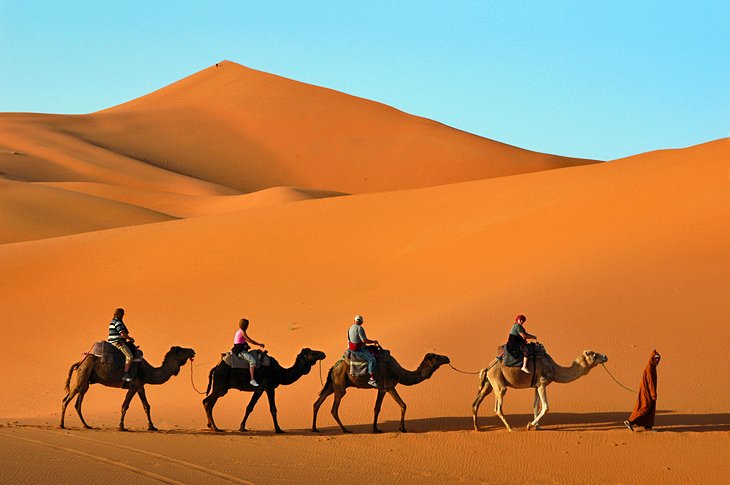Top rated Morocco travel attractions: Our staff of professionals, all members of the highest-rated travel company. Will ensure that we live up to our promise. We will be thrilled to guarantee that you have a smooth transaction. Our approach ensures that you will gain the maximum benefit and top-notch quality. Moreover, We guarantee that you will have a great Visit to Morocco with your loved ones. If you have a tight deadline and a lot of details to organize, do not worry! Just reach out to us, and we will make your dreams come true. See more information at travel agency in Morocco.
Being North Africa’s highest mountain range, High Atlas is popularly known as the mountain of mountains. This place is a paradise for trekkers, especially from spring to autumn. It runs diagonally across Morocco for approximately 1000 km, and its saw-toothed Jurassic peaks act as a weather barrier. Out of all the best places to visit in Morocco, this one is so beautiful that it will take your breath away! Get your hiking shoes out and set off on a journey you’ll remember for life!
The main square in Marrakesh, Djemaa el-Fna is known for its carnival-like ambience. Especially lively in the evenings, fortune tellers, musicians, henna artists, dancers, and people wearing traditional outfits are among the sights to see. The smells of cooking waft through the air and visitors can try an array of Moroccan street food. During the day, highlights include market stalls with a colourful array of wares, snake charmers, and monkeys. A stunning palace in Marrakesh, Bahia Palace dates back to the late 19th century. The large complex has many rooms, as well as gardens and courtyards. With a name that means “Brilliance”, it’s little surprise to find marvellous decorative details on the walls, ceilings, floors, and doors all throughout the former palace.
Hikers, trekkers, and general nature lovers shouldn’t miss a journey into the raw landscapes of Morocco’s Dades Valley. With the snow-capped peaks of the High Atlas in the distance, the big-sky country here is the perfect antidote for those who have been getting frazzled nerves amid the souks of Marrakesh and Fes. There are dinky villages galore; exceptional bird-spotting opportunities; great day-walk options; and views of lush fields and orchards trapped between the orange cliffs of the gorge, snaking out before you.
These lush tropical gardens full of cacti, palms, and ferns, are the work of painter Jacques Majorelle. Originally from the town of Nancy in France, Majorelle came to Marrakesh for health reasons and became well known for his paintings of local Moroccan life. His most famous work, though, was this garden and the vibrant blue (the color now known as Majorelle blue) painter’s studio he lived in on the grounds. After Majorelle’s death in 1962, French fashion designer Yves Saint Laurent bought the property, and upon his death in 2008, his ashes were scattered in the gardens. Majorelle’s old painting studio is now home to a fabulous museum dedicated to Berber artistry. A museum dedicated to YSL’s life and famed fashion legacy is currently being built on the grounds as well.
From Marrakech medina it takes just under an hour to reach the Agafay Desert and Nkhila Lodge. As we leave the bright lights of the city behind and enter the rural province of Al Haouz, the landscape changes from olives groves to the rolling barren hills of the Agafay Desert. Eventually we leave the asphalt behind and follow desert tracks to reach Douar Nkhila village on the eastern edge of Agafay. Our final approach is spectacular: we twist around arid hillsides until reaching Nkhila Lodge, perched on stilts, with the High Atlas mountains looming in the distance. On arrival at camp we will be greeted with a refreshing glass of mint tea and briefed by our host. In the early evening there’s time for a camel ride to enjoy the setting sun over western Agafay. If camel riding is not your thing, there are several short scenic walks to enjoy. Tonight dinner will be served in your choice of location – either in the privacy of your tent, on the balcony, in the dining tent, or under an outside canopy-covered dining spot. Lunch and dinner is included today.
Essaouira is a relaxed fishing port, protected by a natural bay. It was formerly known, by the 16th century Portuguese as Mogador. The present city of Essaouira was only built during the 18th century to increase trade exchanges with the European powers. Nowadays, Essaouira is renowned for its kitesurfing and windsurfing, with the powerful trade wind blowing almost constantly onto the protected bay. Parasols tend to be used on the beach as a protection against the wind and the blowing sand. The medina of Essaouira is home to many small arts and crafts businesses, notably cabinet making and wood-carving. See extra information on https://topmoroccotravel.com/.
